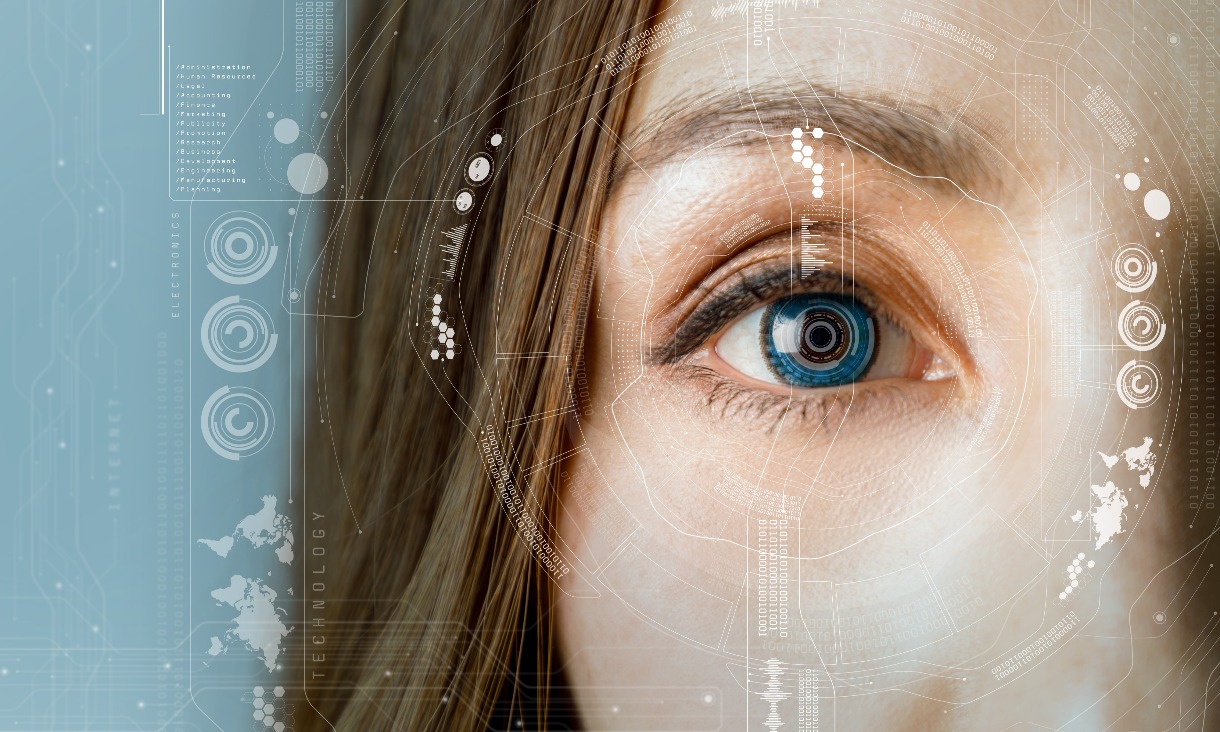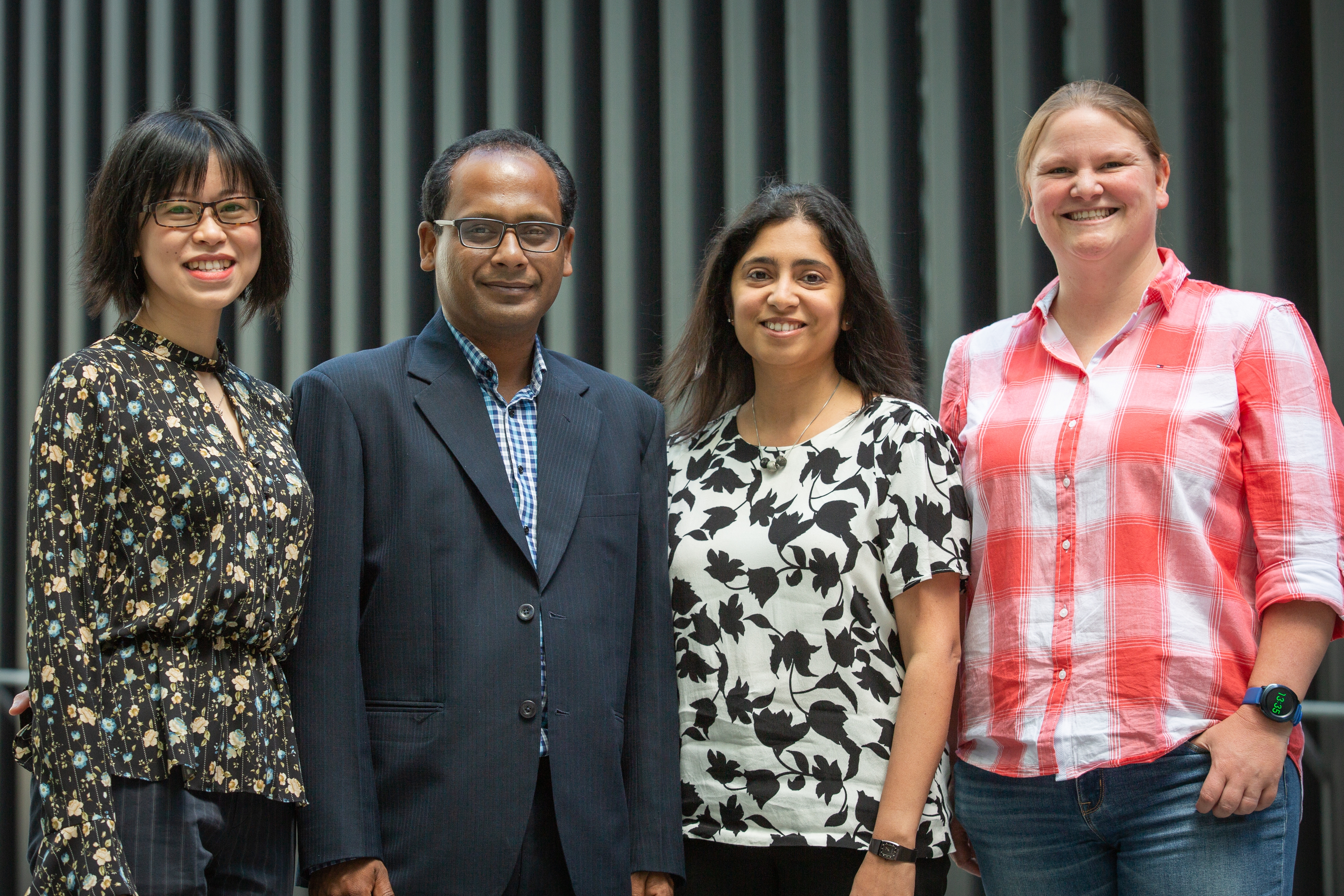
Fantastic four: meet the researchers changing the future of health
Technology is having a huge impact on our health. From 3D-printed diamond body implants to sensors used in bedding to monitor the elderly, predict diabetes in babies or manage sun exposure, the possibilities are many and varied. Here four RMIT researchers talk about the potential impact of their work as we live even longer lives.
 Dr Wenyue Zou, Professor Vipul Bansal, Professor Madhu Bhaskaran and Associate Professor Kate Fox work in different fields but are working towards solutions for aging well.
Dr Wenyue Zou, Professor Vipul Bansal, Professor Madhu Bhaskaran and Associate Professor Kate Fox work in different fields but are working towards solutions for aging well.
Shine bright like a diamond
Diamonds might be your body’s best friend.
That’s what Associate Professor Kate Fox is discovering as she creates 3D-printed diamond body implants in what’s believed to be a world-first.
One in 25 people globally are expected to require an implant of some kind in their life and there were more than 115,000 joint replacements alone in Australia in 2016.
Implants are often made with titanium, which doesn’t always interact with the body the way it needs to, increasing the risk of the implant moving or being rejected. One in 20 replacements need revision within nine years of surgery.
Diamond implants could be more compatible because carbon is a key element inside the human body.
A baby girl born in Australia today is expected to live to 84.6 years old, while a boy is expected to live to 80.5, according to latest available data from the Australian Bureau of Statistics.
Compare that to life expectancy at birth in 1976, which was 76.4 years for women and 69.4 for men.
Fox said her work could offer a solution to the combination of living longer and putting our bodies through intense activities like riding motorbikes and playing football from a younger age.
“The consequences haven’t quite been predicted and it’s a massive problem,” she said.
“While we have some temporary solutions – metal implants, titanium, stainless steel, cobalt chromium – they don’t last.
“You hear about all these old footballers who are getting both hips and knees done at 40, 45. They’ve got a lot of life left in them, so if you’ve got an implant that’s only going to last 15 or 20 years that’s one, two replacements.
“Finding long-term solutions that will last 50, 60 years is the holy grail of bio-medical implant engineering.”
Fox hopes her diamond-coated implants could be trialled within five years and predicted that the opportunities for new implants that haven’t been thought of yet would grow as technology developed.
Better care for the elderly
Bedding products with contactless sensors to monitor movement could be the solution to improving the quality of care for elderly people in nursing homes.
Currently it’s hard to get reliable, non-invasive data for the almost one million Australians in aged care so staff undertake nightly door checks to ensure residents are in bed.
With the number of Australians aged 65 and over expected to double to 8.8 million over the next 40 years, it’s a growing challenge and Professor Madhu Bhaskaran is trying to solve it with manufacturer Sleeptite.
Governments spent about $17 billion on aged care in 2016-17, with more than two-thirds going towards residential facilities, according to Australian Institute of Health and Welfare data.
Indian-born Bhaskaran said the project was all about delivering better care and peace of mind.
“A door check is not always going to give you sufficient information about the person’s health,” she said.
“So, it’s a question of can we have sensors that can non-invasively give you reliable data about the person being in bed verses not being in bed and, with time, can we actually establish if the person is breathing and establish their heartrate?”
Deloitte modelling found the project could save more than $1 billion a year if implemented in a third of aged care and hospital beds.
Sleeptite approached Bhaskaran about working together on a medical device after seeing her previous work developing wearable electronics that are bendable and stretchable.
She said applications for the contactless sensor technology could be widespread.
“If we can get this to work, it could benefit anyone where you need to have some kind of monitoring so newborn babies at risk of SIDS could be another area where the technology could be applied,” she said.
Nanotechnology and sensors to detect disease early
Professor Vipul Bansal explores the power of nanotechnology to solve the big health issues facing our society and environment.
The Director of the Ian Potter NanoBiosensing Facility at RMIT University grew up in Chandausi, India before moving to Australia in 2006.
His team is focusing on developing highly selective, sensitive, ultra-fast and cheap biosensors to reliably detect the source of problems.
“A new nanoparticle we’ve developed combines the attributes of MRI and PET scans to allow early detection of cancer. MRI gives you an overall 3D image of the body but the resolution is very low. Alternatively, PET scans give you a sharp signal, but not the 3D picture. Our technology gives you the best of both.
“We’re working on a nanosensor to predict diabetes in babies. Type 1 diabetes affects 542,000 children globally, with increasing numbers of adults also being diagnosed. Currently there’s no early detection method and by the time people realise their sugar levels are high, more than 80% of damage to the insulin-producing cells is done. If we can detect diabetes before blood sugar starts to spike, we may in future even be able to treat diabetes.
“I have a personal interest in developing ultraviolet (UV) sensors for managing our exposure to sun as I’ve been Vitamin D deficient for many years. We want our wearable sensors to educate people on being sun safe by avoiding overexposure and help them manage their Vitamin D levels.
“A strong force keeping me awake is to keep hunting for new knowledge to benefit our societies and environment. And of course, some of my personal circumstances, such as diabetes and associated ongoing Vitamin D deficiency have given me a direction to focus.”
Wearable sensors for sun safety
New research into photo-active materials and sensor technology is set to combat major health issues including antibiotic resistance and sun damage.
Dr Wenyue Zou is part of the team at RMIT that has developed low-cost personalised ultraviolet (UV) sensors that can be worn as a wrist-band or sticker to help reduce the risk of sun damage.
She began working in Professor Vipul Bansal’s team after arriving in Australia from China in 2014 with a Master in Pharmaceutical Analysis, initially planning not to work but to support her husband who had moved to Melbourne to complete his PhD.
“I read about Professor Bansal’s research into nanotechnology when I was browsing the RMIT website after we arrived and decided to contact him. This one email changed my life! I’ve now completed my PhD in Applied Chemistry and working as a postdoctoral researcher at RMIT.
“Across the globe, more than 40 people die from skin cancer each day and it’s one of the most common cancers. But Vitamin D deficiency is also one of the most common medical conditions, affecting more than 1 billion people worldwide.
“The wearable sensors that we’ve developed contain UV active ink that changes colour when exposed to different UV types. They allow people to monitor their sun exposure throughout the day.
“Monitoring your personal exposure is important because people have different solar UV exposure needs. Those with lighter skin are more sensitive to sun damage, while those with darker skin need more sun exposure to produce Vitamin D.
“We are now working with designers to develop a kid-friendly design and looking to commercialise the product as early as 2020. Long-term, I want to apply more science and technology to solve the problems in our lives. This is a big motivation for me in my work.”
-ends
For interviews or general RMIT media enquiries: +61 439 704 077 or news@rmit.edu.au.
- Advanced Manufacturing
- Science and technology
- Society
- Research
- Nano & Microtechnology
- Industry
Acknowledgement of Country
RMIT University acknowledges the people of the Woi wurrung and Boon wurrung language groups of the eastern Kulin Nation on whose unceded lands we conduct the business of the University. RMIT University respectfully acknowledges their Ancestors and Elders, past and present. RMIT also acknowledges the Traditional Custodians and their Ancestors of the lands and waters across Australia where we conduct our business - Artwork 'Sentient' by Hollie Johnson, Gunaikurnai and Monero Ngarigo.